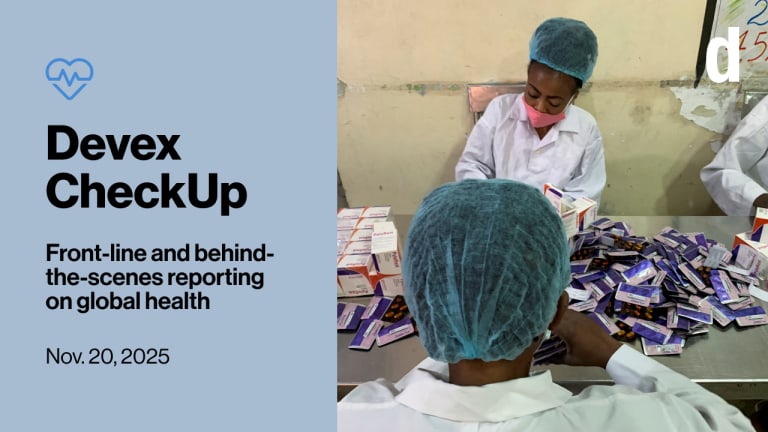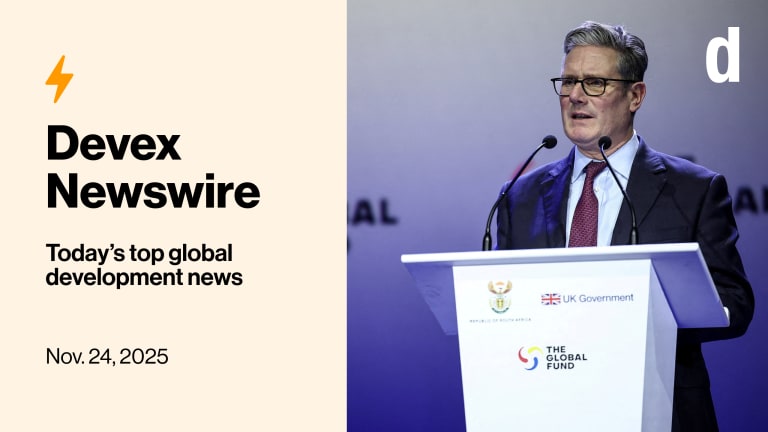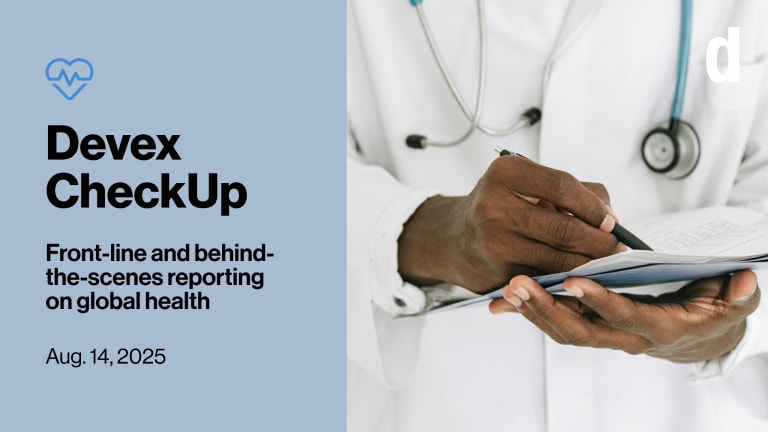
Devex offices are closed this week for an August break. Instead of our regular Newswire, we’re taking deep dives into some of this year’s key development topics. Today, we dig into the fundraising landscape for global health.
Multiple funds and organizations are rallying their donors to give this year — including the World Health Organization; Gavi, the Vaccine Alliance; the International Development Association; and the Pandemic Fund.
Over the past few months, these entities have revealed how much they’ll need in the next few years to deliver on their mandates, and why they are worth donors’ dollars.
The response has been a mixed bag.
While rhetorically several donors have voiced their support for their work, with some already announcing funding pledges ahead of the official replenishment and investment events, others have yet to show their hand — meaning it’s unclear if and how much they will be giving.
This was apparent at the recent launch of the Pandemic Fund’s investment case in Brazil, where it will also be holding its replenishment event on Oct. 31. While the United States made a big splash by announcing an early pledge that covers one-third of the $2 billion fundraising target, followed by Germany with €50 million (about $54 million), other donors voiced their support for the fund but did not make specific pledges — at least not yet. Instead, they called on others to also contribute and expand the fund’s donor base.
The money will be crucial for the implementation of the fund’s new five-year, medium-term strategic plan, which will see a large part of its resources go to countries with the largest gaps in pandemic prevention, preparedness and response, or PPPR, capacity and at the highest risk of pandemics. It will also be crucial for the fund to continue its work, as it anticipates that it will have “exhausted” the bulk of its resources by June 2025.
The event was just the beginning of the fund’s monthslong effort to bring in additional donor financing, and other pledges might be made in the coming months, according to Josh Michaud, associate director for global health and HIV policy at the Kaiser Family Foundation.
“But, we have to note that the Pandemic Fund’s investment case is only one of a number of global health and development fundraising efforts taking place over the next months, which raises concerns about potential competition for a limited set of donor funds,” he wrote to Devex.
Read: US pledges $667M to the Pandemic Fund
Plus: Pandemic Fund eyes $2B funding target to kick-start new strategic plan
ICYMI: Where does the Pandemic Fund stand in its second year? (Pro)
+ Not yet a Devex Pro member? Start your 15-day free trial today to access all our expert analyses, insider insights, career resources, exclusive events, and more. Plus, you’ll get a discount for October’s Devex World 2024, a special event to connect with leaders, including health luminaries, shaping the future of global development.
One of US
The upcoming U.S. presidential election is one to watch for the global health sector, simply because the United States is the largest donor to global health.
In fact, the U.S. was the top donor to IDA, during its last replenishment, as well as the top contributor to WHO. And so far, it’s leading the charge for the replenishments of both the Pandemic Fund and Gavi, pledging $667 million and $1.58 billion to the two, respectively.
Both pledges show an increase from previous U.S. contributions. But they come with caveats.
The U.S., by law, cannot give more than one-third of all donor contributions to the Pandemic Fund. That means if the Pandemic Fund fails to reach its fundraising target of $2 billion, then the full U.S. pledge cannot materialize.
A similar law is in place for contributions to the Global Fund to Fight AIDS, Tuberculosis and Malaria. The U.S. initially committed $6 billion to the Global Fund for its current replenishment period, the largest of all donors. However, to date, the fund has only raised $15.7 billion in pledges. It could lose $1.2 billion in potential U.S. funding if it fails to raise more resources.
Some are hopeful that the resources will come through. However, it poses questions for the Global Fund’s next replenishment anticipated in 2025.
If donors are not putting forward the money now, “it’s hard to imagine why in the next couple of years they would reverse these decisions,” Pete Baker, deputy director of the global health policy program at the Center for Global Development, told Jenny back in March.
A WHO new world
One organization trying out something new to secure more predictable funding is WHO, which launched its first investment round in May and will be holding a fundraising event in November. It’s asking for $11.1 billion to fund its work over the next four years — of which it expects the world’s countries will pay $4 billion in membership dues, leaving $7.1 billion for it to fundraise from governments and the private sector.
This is a new approach — the public health agency has never bundled fundraising like this into a four-year package. It’s trying out something new because, for decades, it has been at the mercy of donor funds flowing in unpredictably and tied to certain projects, meaning WHO hasn’t been able to engage in long-term planning nor direct money to the areas it deems most pressing. For example, over 60% of country office staff are on short-term contracts.
But the agency doesn’t see itself in competition with other global health replenishments.
“WHO must be adequately financed to fill its technical and coordinating role in global health, which in turn enables the success of partners — indeed, if WHO did not exist, other organizations would have to replicate its functions and their asks would be correspondingly higher,” the organization argues.
Playing a modest role in the fundraising will be the WHO Foundation, which was launched in 2020 to expand the agency’s donor base and reap money from philanthropic organizations, companies, corporate foundations, and the general public. It aims to raise $50 million for the investment round.
The investment round was launched during the World Health Assembly, where an initial $278 million was pledged. Contributors are encouraged to announce their pledges at a series of upcoming events, the first of which is at the end of August.
Read: WHO launches first investment round, asking for $11 billion
ICYMI: The foundation bringing in private sector finance to WHO (Pro)
Thanks, COVAX
Gavi launched its replenishment campaign in June. It’s asking for $9 billion in new pledges, out of a total need of $11.9 billion to fund the organization’s work from 2026 to 2030. It secured more than $2.4 billion toward this goal during the launch.
Gavi CEO Sania Nishtar said she is “cautiously optimistic” that the organization will achieve its fundraising target. They have a clear plan on what they will do with the money, have demonstrated impact, and operate on a cost-sharing model with countries, she said.
But where will the remainder come from? There is $2.9 billion already available in existing donor pledges, investment income, and leftover resources from the COVID-19 pandemic.
Part of the unspent COVAX funds are being repurposed for the African Vaccine Manufacturing Accelerator, a $1 billion financial instrument set up to support sustainable vaccine manufacturing on the continent. This new financial instrument will provide strategically timed grants to support and incentivize African manufacturers to enter into vaccine production and to help in building a broader ecosystem to ensure the sector becomes globally competitive in ways that outlast this initial financial support.
At the event, several sovereign donors as well as the Gates Foundation committed to invest about $1.2 billion in AVMA. A number of the commitments were “primarily through strategic reallocations of COVID-19 funding,” according to Gavi.
Read: Gavi launches $9B replenishment target
Related: High risk, high reward — Gavi’s investment in Africa vaccine production
One big number
$100 billion
—That’s what IDA, the World Bank’s fund for low-income countries, hopes to raise through a new cycle of funding. It’s the world’s largest anti-poverty fund, committing $42 billion in 2022 toward health, energy, transport, education, private sector development, and social protection projects.
World Bank President Ajay Banga said he is hoping the total amount adds up to $100 billion. If IDA’s donors can put together around $28 billion to $30 billion, then the bank can leverage those funds on capital markets by up to four times, which would elevate the funding to over $100 billion, he explained in April.
But it is a tough year for replenishments, with a lot of big donors, particularly in Europe, cutting their foreign assistance budgets, and some shifting their aid away from the lowest-income countries.
Even if countries maintain the level of contributions they give IDA, that would still mean fewer dollars due to the depreciation of other currencies against the U.S. dollar — the currency used by countries in pledging to IDA, Clemence Landers, a senior policy fellow at the Center for Global Development who was involved in IDA’s last replenishment, tells Jenny.
U.S. politics could also have an impact on its replenishment. If Donald Trump wins the U.S. presidential election, his administration isn’t expected to be a big supporter of multilateralism or foreign assistance, she adds.
But non-G7 donors could help bridge the gap. South Korea is hosting the IDA replenishment meeting in December, and China has also stepped up its contributions to IDA over the years.
Read: Banga aims for $100 billion in IDA replenishment
Plus: African leaders set out IDA funding priorities at World Bank summit
If you liked this deep dive, you’ll like Devex CheckUp, our free, must-read weekly newsletter for exclusive global health news and insider insights. Sign up today.
Sign up to Newswire for an inside look at the biggest stories in global development.









